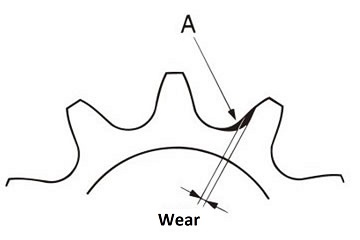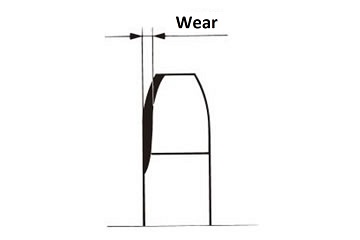Technical Data Small size conveyor chain Handling
Usage Limits
1. Chain Wear Elongation
The chain should be measured by stretching it slightly to remove any backlash or looseness. Measure the distance of the inside (L1) and outside (L2) of rollers at both ends of the measured links to obtain measurement (L). When measuring, use at least 6 to 10 links to help keep any measuring error to a minimum.

Standard length = Chain pitch × No. of links
The chain should be replaced when wear elongation is greater than 2% of the chain pitch.
※A chain wear measurement scale that allows easy checking of pitch stretch is available from Tsubaki.
For Lambda Chain, if the chain elongation reaches around 0.5%, then its oil has run out. This may be determined by the adhesion of red wear particles between the plates and the occurrence of articulation stiffness.
In this situation the chain is no longer usable and should be replaced.
2. R-roller
When wear between the bush and roller causes the under surface of the link plate to contact the guide rail, the chain has usually reached the end of its usable service life.
When the link plate starts contacting the guide rail, rolling contact suddenly turns into sliding contact between the link plate and rail, resulting in greater wear, an increase in chain load, and a reduction in transmitted power.
3. S-roller
The chain has reached the end of its service life as soon as holes or cracks appear on the rollers due to wear.
4. Plate
For conveyor configurations in which link plates move directly on the material to be conveyed or on a guide rail, the service life has come to an end when the worn section equals H/8, as shown in the drawing.

Fig. 30. Plate Width Wear
5. Sprocket
When the sprocket is worn as illustrated below (to the left), the chain is prone to being caught by the tips of the teeth (A), making the disengagement of the chain from the sprocket difficult, hence resulting in vibration of the chain.
Though wear allowance depends on the type of conveyor and the size of the chain to a certain extent, if the sprocket is replaced when the wear reaches 0.3 to 1.0 mm, damage to the chain can be avoided.
When the sprocket is worn in the direction of the tooth width as illustrated below (to the right), the shaft may not be properly aligned and should be corrected.


Fig. 32. Sprocket tooth wear

